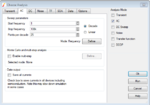kanmaedexandzelbladex
Member level 1
- Joined
- Jul 20, 2013
- Messages
- 35
- Helped
- 1
- Reputation
- 2
- Reaction score
- 1
- Trophy points
- 8
- Location
- Philippines
- Activity points
- 479
Hi everyone I am trying to measure the loop gain of my Boost Converter (Vin = 15V, Vout = 30V, up to 10A load) using the free version of the SIMetrix software, SIMetrix/SIMPLIS Intro 7.00. I am measuring the overall loop gain (outer voltage loop, including the current loop) in order to check the phase and gain plots for stability purposes. The controller used is the UC3843 controller also available in SIMetrix.
The problem is I can't believe that I am doing it right since the resulting plots are exactly the same regardless of whether I shut down the IC, change the compensation values drastically. The magnitude gain is very low ~ -50dB below at 1Hz up to 100kHz which is weird. It is weird since the resulting plots of output voltage curves are totally good and ok from no load up to 10A.
I used AC analysis. Attached here are images of the schematic, the options I chose in the Simulator->Choose Analysis window, and the plot which remains the same regardless of compensator values. The plots change when I change the load, but the magnitude gain is still very low.
Some explanations to the schematic: input voltage is V1 (displayed as 15V in schematic), load is I1 (displayed as 8A in the schematic), C4,R15,C5 are the compensators Type II compensator, Q2 and R10 comprise the slope compensator, I used 3 parallel NMOSFETS IRF32105 each having Rg = 10 ohms and Rgs = 30kohms. V3 is the perturbation, and the probe used is the Bode Plot Probe.
The problem is I can't believe that I am doing it right since the resulting plots are exactly the same regardless of whether I shut down the IC, change the compensation values drastically. The magnitude gain is very low ~ -50dB below at 1Hz up to 100kHz which is weird. It is weird since the resulting plots of output voltage curves are totally good and ok from no load up to 10A.
I used AC analysis. Attached here are images of the schematic, the options I chose in the Simulator->Choose Analysis window, and the plot which remains the same regardless of compensator values. The plots change when I change the load, but the magnitude gain is still very low.
Some explanations to the schematic: input voltage is V1 (displayed as 15V in schematic), load is I1 (displayed as 8A in the schematic), C4,R15,C5 are the compensators Type II compensator, Q2 and R10 comprise the slope compensator, I used 3 parallel NMOSFETS IRF32105 each having Rg = 10 ohms and Rgs = 30kohms. V3 is the perturbation, and the probe used is the Bode Plot Probe.



